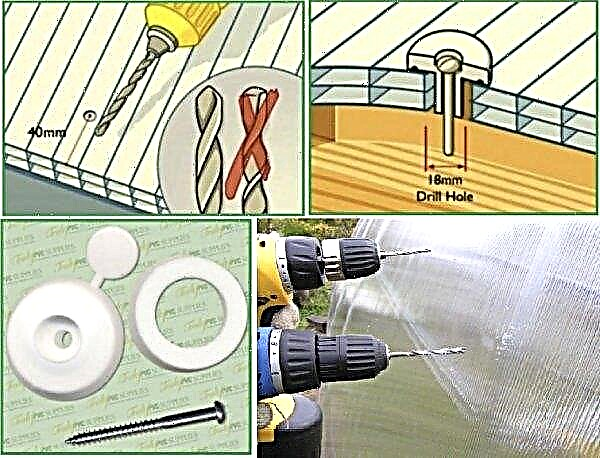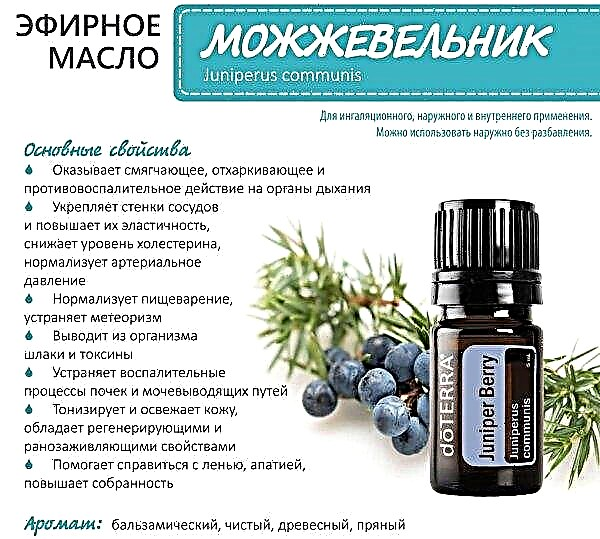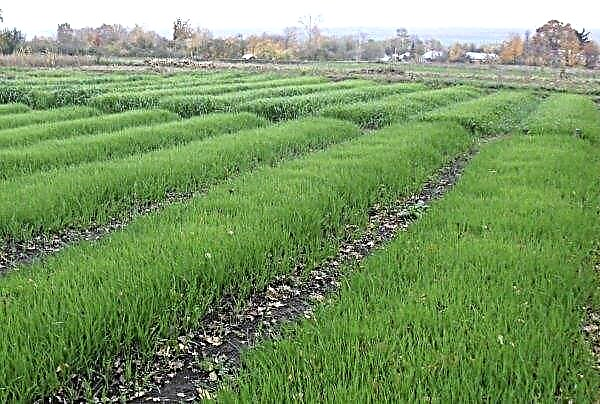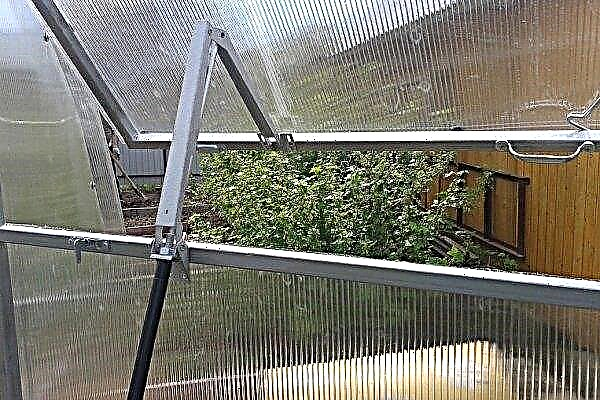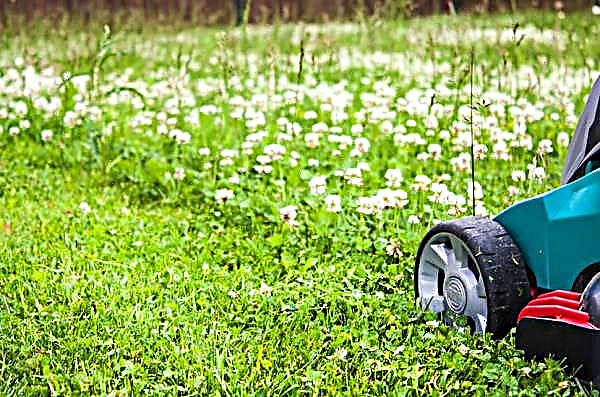The flowering of the Uzambara violet (senpolia) begins in November and lasts until spring. Her flowers cheer up on winter evenings when there are so few bright colors. In this review, we will focus on the two-color violet Le Esenia from Vinnitsa breeder Elena Lebetskaya.
Botanical description of the plant
Esenia (Le Esenia) is characterized by large blue-violet-white flowers with the finest ruffle along the edge of the petals. Over a medium-sized outlet, up to 40 five-petalled flowers rise. The diameter of the flowers is 3-5 cm. The color of the flowers is not stable and can vary from plant to plant: be lighter or darker. Saintpaulia blooms from September to March. After flowering, each flower forms a small seed box. A plant can propagate both by seeds and leaves. Leaf outlet about 40 cm in diameter (standard). The leaves are large, oval, dark green on the middle petioles. The stem is the base of the basal rosette. It can be longer or shorter, depending on the age of the violet. The root system is fibrous, consisting of many identical roots.
A plant can propagate both by seeds and leaves. Leaf outlet about 40 cm in diameter (standard). The leaves are large, oval, dark green on the middle petioles. The stem is the base of the basal rosette. It can be longer or shorter, depending on the age of the violet. The root system is fibrous, consisting of many identical roots.
House growing conditions
Senpolia can be placed on the windowsill or on separate shelves, shelving and other surfaces.
Did you know? Some flower growers claim that Esenia flowers have more white when the air gets cooler, and in a warm microclimate they acquire a dark blue hue.
For good development and growth, they will need:
- lighting - moderate, indirect light;
- watering - it is necessary that the soil is slightly moist;
- air - exclude the presence of drafts and temperature extremes.
Location and Lighting
Lighting must be bright, but indirect. This will happen if Le Yesenia is placed on the western or eastern windowsill. In such conditions, the sun will well illuminate the violet during the first or second half of the day. The correct luminosity for the senpolia is about 11,000 lux. Light intensity depends on the time of year. Therefore, violets may need to move to another windowsill if the lighting conditions change. Remember to turn the plant ¼ turn after each watering. This will ensure uniform development of the leaf outlet. If this is not done, then it will stretch in the direction of the light source. When using artificial lighting, keep in mind that the distance between the light source and the plant should be at least 0.5 m.
Remember to turn the plant ¼ turn after each watering. This will ensure uniform development of the leaf outlet. If this is not done, then it will stretch in the direction of the light source. When using artificial lighting, keep in mind that the distance between the light source and the plant should be at least 0.5 m.
Important! Provide Yesenia with an 8-hour period of darkness per day. This will help activate the flowering hormone.
Temperature and humidity
In choosing comfortable conditions for development, people and violets coincide.
What is comfortable for you will be comfortable for the senpolia:
- air temperature - about + 21 ° C;
- the absence of sharp fluctuations in day and night temperatures;
- optimal humidity - from 70 to 80%.
 There should be enough space around the flower for air circulation. This will help protect the flowers from pests and phytopathogens if one of the violets gets sick.
There should be enough space around the flower for air circulation. This will help protect the flowers from pests and phytopathogens if one of the violets gets sick.How to care
Senpolies will definitely need:
- support for optimal indoor climate;
- properly organized watering;
- the introduction of periodic top dressing;
- periodic transplantation and thinning outlets.
Watering
Measuring soil moisture is quite simple: lower your finger 1 cm into the ground. If you do not feel moisture, then the plant needs to be watered. The best way is considered to be lower watering, in which the root system takes water from a water pan. Esenia can be installed in such a tray for 20-30 minutes, and then remove excess water. This will help prevent waterlogging. It is desirable that the water temperature does not differ from the air temperature in the room.
Important! Plain tap water — hard, suitable for irrigation. But if there is a filter on the trunk, then you will get soft water, harmful to violets. It changes the acidity of the soil, which can lead to a loss of ability to absorb nutrients.
The main thing in irrigation is not the frequency or reference to a specific number of days between them, but the degree of soil moisture. This parameter depends on the air temperature in the room and the season (in winter you can water less often). Water as needed.
Fertilizer application
Violet fertilizers are needed during the flowering period. You can buy special fertilizer for violets in the store or make it yourself. Mandatory components of the fertilizer: potassium, phosphorus, nitrogen. Phosphorus should be 2 times more than other components. For example, 15 × 30 × 15. Frequency of application - 1 time in 2 weeks.
To understand whether you need to fertilize the plant - inspect Esenia visually. Pale or underdeveloped leaves are a sign of a lack of nutrients. In this case, fertilizer must be applied. If the violet looks great, just add ¼ of the top dressing rate at each watering. It is advisable to purchase complex mineral fertilizers. The rate of use of the substance is indicated on the package.
Pruning
In pruning, like garden trees, violet, of course, does not need. But it is necessary to remove faded peduncles, damaged leaves. At a time when the senpolia does not bloom, you observe the spherical shape of a leaf rosette. The resulting flower stalks need a place to get to the surface to the light and the sun. Therefore, a thick outlet necessarily thin out. Any deformation of the leaves can be a sign of illness and such leaves must be removed, as well as treat the plant with an appropriate fungicide. Removal Technique:
Removal Technique:
- Sanitize the scissors.
- Trim damaged or dry parts of the Saintpaulia.
- Disinfect the scissors again.
- If you find other leaves in a day or two after the previous pruning, you also need to prune them.
- Check the condition daily and remove all those leaves that you find after the first pruning.
Did you know? Violets have been cultivated for centuries. The Greeks used them to make wines, food, and medicine. They loved violets so much that they made this flower a symbol of Athens.
Transfer
The optimal time for transplanting is after flowering. For most varieties, this is spring. At this point, the senpolia passes into a period of rest and easier to tolerate the procedure. It is believed that it should be transplanted once a year due to the fact that the soil is depleted and the plant will receive more nutrition on the new soil. But this is not quite the right opinion: you still feed every 2 weeks. Therefore, it will be correct to transplant the plant when it begins to outgrow its pot. Transplant Technology:
Transplant Technology:
- Get a pot that will be 1/3 larger than the size of the leaf outlet.
- From equal parts of peat moss (sphagnum), perlite and sand, mix the planting mixture.
- Moisten the soil with water.
- Remove the senpolia from the old pot.
- At the bottom of the new pot, lay the drainage, and then the soil mixture.
- Place the violet in the center of the pot.
- Add soil.
- Water the plant after transplanting.
How to propagate at home
Violet can be propagated by seeds, leaves or parts thereof.
Did you know?Violets have a unique smell. By breathing it in, you temporarily lose the ability to perceive other odors. Flowers contain a chemical called ionon, which causes the weakening of the scent.
Most often, leaves are used for the following reasons:
- it is much faster;
- so violet retains all its varietal characteristics.
Instructions for propagating violets leaf:
- Choose a healthy large leaf on the plant. Do not take old leaves, they will not form a healthy plant.
- Cut the top of the sheet at an angle so that about 75% of the sheet plate remains. This will speed up germination.
- Fill a small pot with the same soil mixture used for transplanting.
- Moisten it with water.
- Set the leaf down in it. Do not bury the sheet plate into the ground.
- Put the pot in a plastic container and cover with a film to create optimal conditions for growth.
- After a while, a small new plant will appear next to the leaf.

Growing difficulties
All plants are periodically attacked by pests or may become ill. The reasons are non-compliance with growing conditions: high or low humidity, low air temperature, too violet planting and other factors. Most pests of leafy plants move through the air, so there are no absolute ways to protect against them. But insects can be noticed in time and take action.
Signs of pests:
- deformation of the sheet plate;
- gnawing leaves;
- visual presence of insects or their larvae.
Signs of root rot and other diseases:
- yellowing and fading leaves;
- slow growth of the plant;
- the presence of spots on the leaves.
Violet Treatment:
- Remove the plant from the pot.
- Check the root system and remove any damaged roots.
- Any damaged parts should also be removed.
- Treat the violet and anti-rot roots with an appropriate fungicide.
- Transplant the plant into a new pot and new soil.
 Be sure to normalize the irrigation of violets in order to prevent waterlogging of the soil. Stains on the leaves can occur due to an excess of light - a sunburn. In this case, the plant needs to be rearranged away from sunlight. It is not difficult to grow Esenia. It is enough to organize for her optimal conditions for development. Observing the rules of watering, fertilizing and caring for plants, you will definitely get a long flowering violet and a lot of positive emotions.
Be sure to normalize the irrigation of violets in order to prevent waterlogging of the soil. Stains on the leaves can occur due to an excess of light - a sunburn. In this case, the plant needs to be rearranged away from sunlight. It is not difficult to grow Esenia. It is enough to organize for her optimal conditions for development. Observing the rules of watering, fertilizing and caring for plants, you will definitely get a long flowering violet and a lot of positive emotions.





